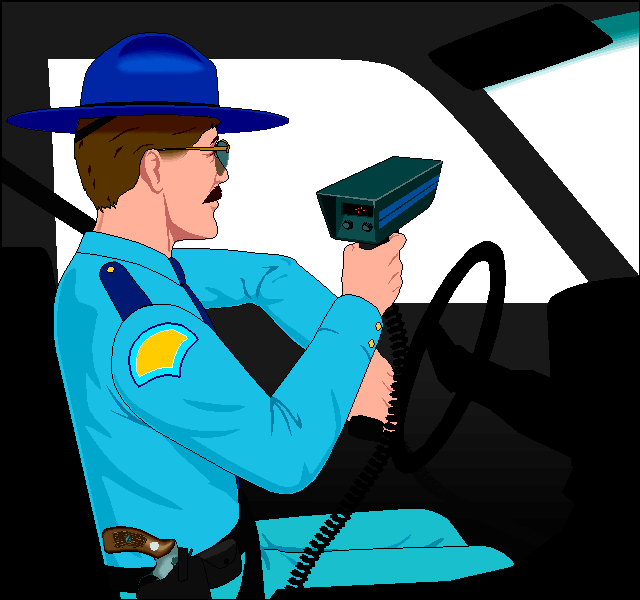 LIMITS
LIMITS
 LIMITS
LIMITSSomeone once wrote --
"Enlightened governments only pass laws which 95% of their constituents will voluntarily obey. Those governments that rely on force, coercion, or terror to obtain compliance will fall -- it's only a matter of time!"
After all, most revolutions have succeeded with a total commitment from only about 7% of the population. Society's so-called "have's" are about 5% of most populations, and the overall condition of the remaining 88% of the society does not change significantly irrespective of who is in power.
On a long auto trip to Iowa during December, we decided to look at the landscape and John Q. Public's driving performance in some detail. Andy Rooney had piqued our curiosity about the speed limit and safety during a recent 60 Minutes segment. The 1,800 mile trip was made using our automobile's cruise control to maintain our speed at two (2) miles over the posted speed limit. The speedometer was checked for accuracy before the trip.
During this trip, we overtook only about 5% of the cars on the road. In effect, 95% of John Q. Public's vehicles were exceeding the speed limit at all times. Thus, those drivers were considered offenders by the law enforcement community and candidates for the higher-risk insurance coverage pools by their insurance companies.
Some towns sitting on a major thoroughfare have found themselves with a method of increasing their revenues by hiring police officers whose major duty is issuing speeding tickets. For instance, the town of Stringtown, Oklahoma (population 366) has a budget for fiscal 1992 of $426,000 and expects traffic fines levied largely against out-of-state drivers to bring in $270,000, or 63%.
With an average speeding ticket fine in excess of $50, the Stringtown police must issue over 100 tickets per week for speeding to meet the town's revenue requirements. Talk about highway robbery.
Of course, the out-of-state driver is the target of choice. To fight the ticket requires the alleged offender to hire an attorney, take time off of work and drive or fly back to appear before the municipal court ten days later to have justice dispensed. Is it any wonder that over 90% of these tickets are paid without a court appearance!
Our analysis of the neighboring city of Atoka, Oklahoma (population, 3,298) for a two month period in 1990 indicated that over 85% of the speeding tickets were issued to out-of-state drivers. However, the city of Atoka only budgets 24% of its annual fiscal 1992 revenue from traffic fines. It boggles this mind that a small percentage of out-of-state vehicles are responsible for such a high percentage of offenses!
It seems to me that legislators and law enforcement must be aware that John Q. Public disregards the 55 MPH speed limit. Any drive on any highway would educate the observer to the facts. Just perhaps, John Q. is a better judge of what constitutes safe operating conditions than a bureaucracy? After all, self-preservation is a powerful instinct in most animals.
During the 20th century beginning with prohibition, our government has fostered laws which are not obeyed and which deal with moral issues as opposed to regulating conduct between people on the basis of "doing unto others as you would have them do unto you."
Many states have changed their speed limits over the past eight (8) decades to take account of increased traffic, better roads, and political pressure. I can remember traveling in Western states on two-lane non-divided highways where the speed limit was posted as "safe and prudent for the conditions." The police hated this because the burden of proof for speeding was thus placed upon the officer and they successfully lobbied to get the speed limit set at 75 MPH.
The 55 MPH speed limit was enacted by the federal government as a device to save energy. However, the major reason for the oil crunch was the Environmental Protection Agency's decision to measure vehicle exhaust emissions in parts per million of gasoline burned rather than parts per million of gasoline used per mile traveled.
The result of this definition was a decline of 50% in the average fleet gasoline consumption per mile traveled in just 10 years. As total miles traveled continued to increase, the decrease in average fleet mileage caused by catalytic convertor technology increased gasoline consumption sharply. Coupled with a change in the US oil depletion allowance by Congress, it is no wonder that domestic oil reserves decreased sharply. US oil imports gradually increased until now imports are over 50% of oil consumption. Yet, has Congress ever acknowledged the negative impact of its legislation?
The 55 MPH speed limit is a law which is almost universally disobeyed. It is time for the federal government to repeal this law if for no other reason than it does not promote safety and leads to widespread disrespect for law and order.
Most of the US highways in use today were designed to be safe at speeds from 75 to 80 miles per hour by average drivers. The Interstate Highway system was designed for 80-90 miles per hour.
More importantly, these design specifications were drawn up in the early 1950's when the technology of our automobiles was not as good as today. For example, today's automobiles with power disk brakes will stop in a shorter distance.
As many readers are aware, automobile insurance rates are set on the basis of a point system which takes into account a number of factors including the type of car, the age & occupation of the driver, the number of citations, drivers education courses, collisions at fault, and credit history.
The industry continually squawks about losing money because of increased medical costs, increased costs to repair vehicles, and higher overheads. Nevertheless, do you see any auto insurance company taking steps to own and operate their own vehicle repair centers to reduce costs?
Or do you see any insurance company entering into a long-term contract with either an OEM or replacement parts manufacturing company to get volume discounts on parts to be used in repairing their policy-holders automobiles?
Of course not! The insurance industry operates basically in a cost-plus environment. Annually, the industry goes before state insurance regulatory agencies in each state and argues for increased rates on the basis of their expenses.
To help offset their constantly (?) increasing costs, and in the name of increasing safety (?), some insurance companies are giving police departments the new infrared radars which can not be picked up on most current radar detectors. The rational for doing so is that conventional radar detectors have assisted speeders from being caught. But technology will soon catch up!
However, I suspect that the real reason the insurance company is willing to give these expensive radar units to police departments is not safety, but rather the fact that if only 10-15 of their policy-holders are given tickets during a year, they will be able to increase their unlucky policy-holder's premiums more than enough over the next three years to pay for the radar units.
John Q. Public just might perversely think the police and insurance companies were in the speed limit game only for the money, and safety considerations were only the window-dressing justification.
Let's look for a moment at the actual factors creating most highway accidents.
In 1990, the Federal Highway Administration reported that at least one of the drivers involved in over 55% of the 45,000 fatal accidents nation-wide were under the influence of some type of foreign substance, i.e., alcohol, drugs, and/or medication, which would cause impaired reactions and/or judgment. Note that although speed might have been involved, use of a foreign substance was most significant.
Stopping people from driving under the influence would eliminate 50% of fatal accidents and about 33% of all accidents alone!
The Texas Department of Public Safety reported that in 1990 only 3.2% of all accidents were primarily attributed to speeding. Failure to yield the right-of-way was listed as the primary cause in almost 20% of all accidents. Alcohol and drug usage was a factor in 9.9% of all accidents and was a factor in 37.7% of all fatal accidents. Weather, i.e., rain, ice, sleet, snow, dust, and fog, was listed as a major contributing factor in about 14% of the accidents. Defective roads caused another 9% of accidents. Mechanical defects caused less than 2% of all accidents. Speed may have been involved but other factors were also present in these cases.
It is real easy to lay the blame for the accident rate at the doorstep of speeding. However, if U.S. accident rates are compared with European countries where speed limits are generally much higher, it is difficult to rationalize our 55 MPH limit as being highly beneficial to increased safety.
Traveling over long stretches at speeds approaching 55 MPH tends to create a sense of boredom in the driver and might cause the driver to become inattentive. Higher speeds require greater concentration by drivers and the increased flow of adrenaline keeps drivers alert.
We have just completed another 360 mile automobile trip to Oklahoma. This time we kept detailed records of each posted speed limit change and the number of cars and trucks which were encountered. The results were amazing to us.
In metropolitan areas, vehicles were traveling at average speeds of 10-15 miles per hour in excess of the posted speed limits. On divided highways where little traffic was encountered, vehicles were traveling at average speeds of 5-9 miles per hour in excess of posted speed limits. In rural cities and towns, vehicles traveled at speeds between 1-5 miles per hour in excess of the posted speed limit.
The type of highway did not seem to have much effect on the average speed. Road conditions ranged from wet to dry. The weather changed from a high overcast sky to occasional rain showers and then fog which cut visibility to less than 1/4 mile. These were the factors more likely to affect the average vehicle speed than any posted speed limit.
In other words, most drivers were able to adjust their driving to take into account conditions which they deemed to be safe. They did not need a speed limit sign to arbitrarily limit their speed.
If most rush hour traffic on Dallas-Ft. Worth's expressways travels at 65-70 MPH unless slowed down by traffic bottlenecks, and the cars are bumper to bumper four and five lanes across, and the accident rate is not materially different per thousand miles traveled than rural areas, is it not time to ask, why do we continue the charade of the 55 MPH speed limit?
John Q. Public should demand an immediate change to the federal mandate -- after all less than 50% of the population drank alcoholic beverages when they repealed prohibition. Now, 95% of our drivers fail to obey the posted speed limits.
Is it any wonder that we have little respect for law enforcement these days when laws are passed that John Q. Public refuses to obey voluntarily!
Be honest -- when was the last time that you thought the posted speed limit actually was there for your safety?
But isn't that what traffic laws were originally designed to do -- increase safety -- revenue and increased insurance premiums were not considered in those days. But John Q. Public did have respect for law and order.
Maybe it's time for a change!
Check out these interesting web sites for more information on highway safety and speed limits.

 US
Speed traps identified! - Don't leave home without looking here!
US
Speed traps identified! - Don't leave home without looking here!
But then - - 'Tis Only My Opinion!
Fred Richards
February 1992
This issue of 'Tis Only My Opinion was copyrighted by Adrich Corporation in February 1992.
It is intended to provoke thinking, then dialogue among its readers. Quotation with attribution is encouraged.
![]()
![]() 'Tis Only My Opinion
Archive Menu
'Tis Only My Opinion
Archive Menu
Last updated - July 3, 2008